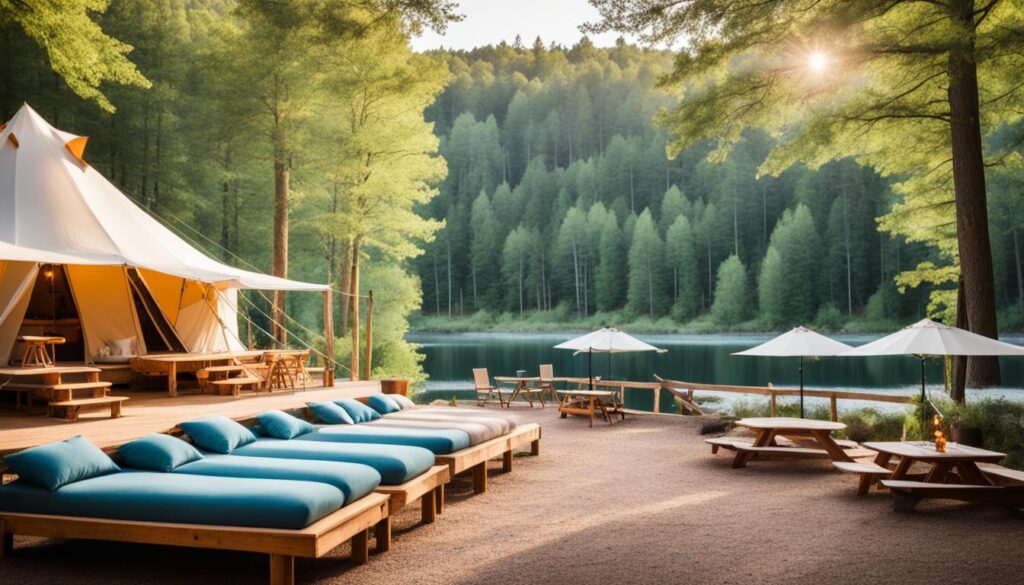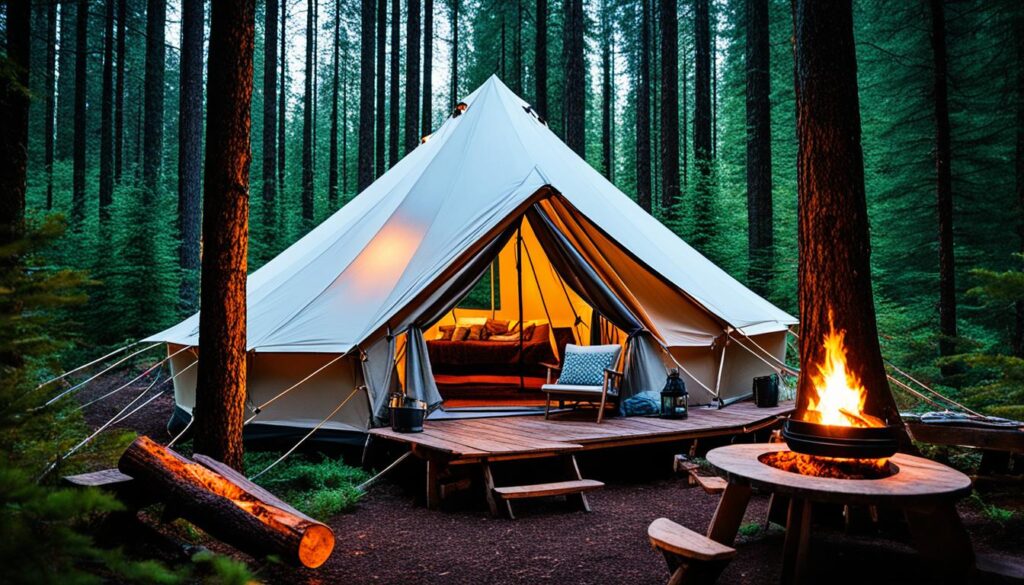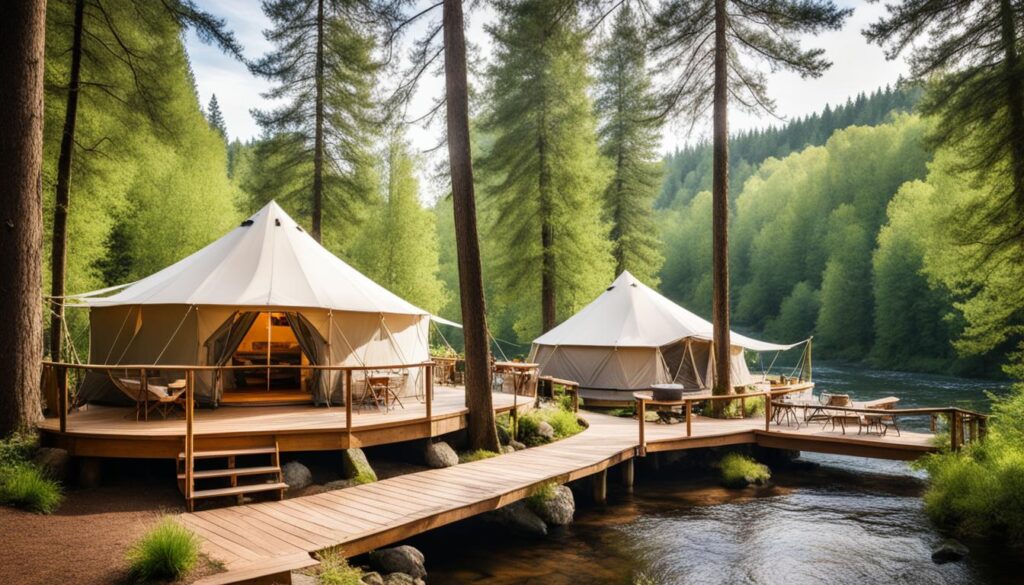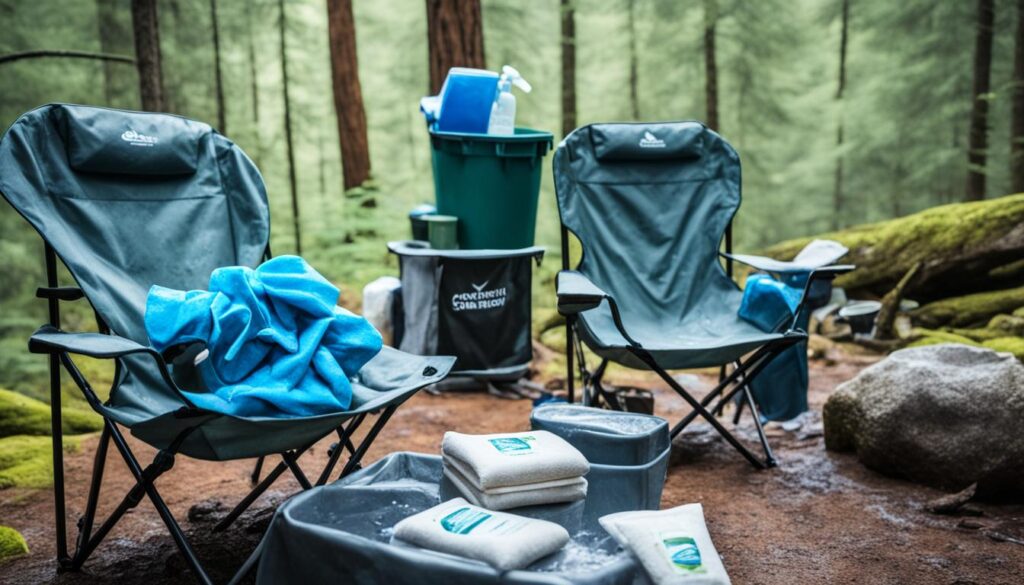Welcome to the ultimate guide on setting up your very own glamping site! If you’ve ever dreamed of creating a luxurious outdoor retreat for adventurous travelers, then you’re in the right place. But before we dive into the nitty-gritty details, let me ask you this: Do you know what it takes to turn a beautiful piece of land into a thriving glamping destination?
Glamping, a combination of glamour and camping, has become increasingly popular in recent years. It offers a unique and upscale experience that combines the beauty of nature with the comforts of modern amenities. But setting up a successful glamping site requires careful planning, attention to detail, and a deep understanding of your target market.
In this comprehensive guide, I will walk you through the essential steps and tips for creating a glamping site that will attract guests and leave them wanting more. From choosing the perfect location to obtaining permits, designing the site, and marketing your business, we’ll cover it all.
Key Takeaways:
- Setting up a glamping site requires careful planning and attention to detail.
- Choosing the right location is crucial for the success of your glamping business.
- The design of your glamping site plays a significant role in attracting customers.
- Navigating the legal requirements and obtaining permits is an essential step.
- Effective marketing strategies are vital for promoting your glamping site.
Contents
Choosing the Right Location for Your Glamping Site
One of the most crucial decisions when setting up a glamping site is choosing the right location. The success of your glamping business depends on finding a spot that offers both natural beauty and accessibility. In this section, I will guide you through the factors to consider and provide valuable tips for conducting market research to help you select the perfect location for your glamping site.
Factors to Consider
- Proximity to Natural Attractions: A picturesque location surrounded by natural beauty will attract more guests to your glamping site. Consider areas near mountains, lakes, forests, or beaches, depending on your target audience’s preferences.
- Accessibility: Ensure your glamping site is easily accessible by road or public transportation. Guests should have no trouble reaching your location, making it convenient for them to enjoy the glamping experience.
- Potential Demand: Research the demand for glamping in different locations. Look for areas with a high number of tourists, outdoor enthusiasts, or people seeking unique accommodation experiences.
By carefully evaluating these factors, you can narrow down your options and focus on locations that align with your business goals.
Conducting Market Research
Market research is a valuable tool that can help you gather insights and make informed decisions about your glamping site location. Here are some tips:
- Study Demographics: Understand your target audience and their preferences. Research their travel habits, interests, and the locations they are most likely to visit.
- Competitor Analysis: Investigate existing glamping sites in potential locations. Analyze their offerings, pricing, and customer reviews. Identify gaps in the market that you can fill with your unique offering.
- Customer Surveys: Conduct surveys or interviews to gather firsthand feedback from potential customers. Ask about their ideal glamping experience and their preferred location.
By combining these research methods, you can gain valuable insights into the demand and preferences of your target market, guiding you towards the ideal location for your glamping site.
When selecting the perfect spot for your glamping business, remember that it’s not just about an attractive location; it’s about creating a unique and memorable experience for your guests.
Designing Your Glamping Site
The design of your glamping site is a crucial factor that can attract customers and create a unique guest experience. When it comes to glamping site design, there are several essential elements to consider.
Accommodation Options
Offering a variety of accommodation options is key to catering to different guest preferences and creating a memorable experience. Consider including luxury tents, treehouses, yurts, or even converted campervans. Each option can provide a distinct ambiance and level of comfort.
Common Areas
Creating well-designed common areas encourages social interaction among guests and enhances their overall stay. Include communal dining spaces, lounges, and fire pits, where guests can gather, relax, and connect with nature and each other.
Amenities
Providing upscale amenities is crucial for a luxury glamping experience. Consider including features like private bathrooms, hot tubs, spa facilities, and eco-friendly toiletries. These amenities will enhance the comfort and relaxation of your guests.
Infrastructure
The infrastructure of your glamping site contributes to its functionality and aesthetics. Ensure that essential facilities such as electricity, plumbing, and heating are in place and seamlessly integrated into the site design. Pay attention to landscaping, lighting, and paths to create a visually appealing environment.
By carefully considering these elements, you can design a glamping site that offers a charming and luxurious retreat for your guests.

Design is not just what it looks like and feels like. Design is how it works. – Steve Jobs
Ensuring Legal Compliance: Permits and Regulations
Before you can open your glamping site to the public, it’s crucial to understand the legal requirements and obtain the necessary permits. Compliance with the regulations ensures the safety of your guests and the smooth operation of your business. In this section, I will guide you through the process and provide an overview of the glamping site permits and requirements you need to consider.
Permits and Licensing
Depending on your location and the specific nature of your glamping site, you may need to obtain various permits and licenses. These could include:
- Land use permits
- Building permits for accommodation units, such as tents, cabins, or yurts
- Health and safety permits
- Environmental permits
- Business licenses
It’s essential to research the local regulations thoroughly and consult with the appropriate authorities to determine the specific permits and licenses required for your glamping site. Failure to comply with these regulations can result in fines, closures, or legal complications, so it’s crucial to prioritize this aspect of your setup process.
Working with Local Authorities
Establishing a good relationship with local authorities is key to obtaining the necessary permits and ensuring a smooth approval process. Here are a few tips to help you navigate this process:
- Research local regulations: Familiarize yourself with the zoning laws, health and safety regulations, and any other relevant guidelines specific to your area. This knowledge will help you understand the requirements and streamline your permit application process.
- Engage with the community: Building positive relationships with the local community can help gain support for your glamping venture. Showing that you value their input and addressing any concerns they may have will improve your chances of obtaining the necessary permits.
- Communicate openly: When submitting permit applications or engaging in discussions with local authorities, be transparent and responsive. Clearly explain your plans, address any potential concerns, and provide detailed documentation to support your proposals.
- Seek professional guidance: If you’re unfamiliar with the local regulations or find the process confusing, consider hiring professionals, such as attorneys or consultants, to assist you. Their expertise can help navigate potential challenges and ensure compliance.
Meeting Glamping Site Requirements
In addition to permits and licenses, your glamping site must meet specific requirements to ensure the safety and comfort of your guests. These requirements may include:
- Proper sanitation facilities, such as toilets and showers
- Fire safety equipment and procedures
- Adequate access and parking for emergency services
- Compliance with environmental regulations, including waste management and protection of natural resources
By adhering to these requirements, you create a safe and enjoyable environment for your guests, as well as demonstrate your commitment to responsible business practices.
| Permit Type | Corresponding Authority | Application Process |
|---|---|---|
| Land use permits | Local planning department | Submit site plans and other required documents detailing your glamping site’s layout, infrastructure, and environmental impact. |
| Building permits | Local building department | Provide architectural plans, structural calculations, and specifications for each accommodation unit. |
| Health and safety permits | Local health department | Demonstrate compliance with sanitation standards, fire safety measures, and emergency response protocols. |
| Environmental permits | State or federal environmental agencies | Submit an environmental impact assessment, waste management plan, and any other required environmental documentation. |
| Business licenses | Local business licensing department | Complete the necessary application forms, pay the required fees, and provide proof of insurance. |
By understanding the permit process, working closely with local authorities, and ensuring your glamping site meets all the necessary requirements, you’ll be well on your way to creating a legally compliant and successful business venture.
Creating a Glamping Site Checklist
To ensure a smooth and successful setup of your glamping site, it’s essential to create a comprehensive checklist. By including all the necessary items and tasks, you can stay organized and on track throughout the entire process. Here is a breakdown of the key elements you should include in your glamping site checklist:
Infrastructure Setup
- Determine the number and type of accommodations (tents, cabins, yurts, etc.)
- Source suppliers for accommodations, furnishings, and amenities
- Create a site layout plan, including parking, pathways, and common areas
- Arrange utility connections for water, electricity, and sewage
- Consider eco-friendly options for energy and waste management
Safety Measures
- Install fire extinguishers and smoke detectors in each accommodation
- Create an emergency response plan and communicate it to staff and guests
- Ensure compliance with local building codes and safety regulations
- Provide clear signage and instructions for emergency exits and protocols
- Regularly inspect and maintain all structures and facilities
Amenities and Services
- Include essential amenities such as toilets, showers, and washing facilities
- Offer additional comfort features like heating, air conditioning, and Wi-Fi
- Consider unique offerings like a communal kitchen, outdoor seating areas, or a spa
- Provide recreational facilities such as a swimming pool, hiking trails, or bike rentals
- Arrange for food and beverage options, either on-site or through partnerships
Marketing Strategies
- Create a compelling website showcasing your glamping site and its offerings
- Optimize your site for search engines using relevant keywords
- Utilize social media platforms to reach and engage with your target audience
- Collaborate with local tourism boards and travel influencers for promotion
- Implement a pricing strategy and consider seasonal discounts or packages
“A comprehensive glamping site checklist helps ensure a smooth setup and successful operation of your luxury outdoor retreat.” – Your Name
By following this checklist, you can prioritize important tasks, avoid overlooking crucial details, and create a glamping site that offers a memorable experience for your guests. Remember to adapt the checklist to suit your specific needs and regulations.
Now, let’s move on to the next section where we’ll explore effective marketing strategies to promote your glamping site and attract customers.

Marketing Your Glamping Site
Once your glamping site is set up, it’s crucial to attract customers and generate bookings. In this section, I’ll explore various marketing strategies and promotional techniques to help you reach your target audience effectively. From developing a strong online presence to forming strategic partnerships and utilizing local advertising, I’ll provide tips on how to successfully market your glamping site.
1. Develop an Effective Online Presence
An online presence is essential for promoting your glamping site and reaching a wider audience. Build a professional website that showcases the unique features and amenities of your site. Optimize your website for search engines by using relevant keywords, creating enticing content, and improving the site’s loading speed. Utilize social media platforms to engage with potential guests and share stunning visuals of your glamping accommodations. Encourage satisfied guests to leave reviews and testimonials on popular travel websites to build credibility and attract more visitors.
2. Leverage the Power of Social Media
Social media platforms offer an effective way to connect with your target market directly. Create compelling content that resonates with your audience, such as breathtaking photos of your glamping accommodations and engaging videos showcasing the unique experiences offered on-site. Regularly post updates, promotions, and special offers to keep your followers engaged and interested. Collaborate with social media influencers or partner with local businesses to expand your reach and tap into new markets.
3. Utilize Email Marketing
Email marketing is a powerful tool for nurturing leads and maintaining relationships with past guests. Build an email list by offering exclusive discounts, updates, and relevant content to those who subscribe to your newsletter. Personalize your emails and segment your audience to deliver targeted offers and recommendations. Create compelling email campaigns that highlight the unique aspects of your glamping site and entice recipients to book their next adventure with you.
4. Collaborate with Local Businesses and Influencers
Forge partnerships with local businesses and influencers in the travel and outdoor industry to expand your reach and attract new guests. Collaborate on joint marketing campaigns, offer special discounts, or organize unique experiences that complement each other’s offerings. By leveraging the networks and credibility of these partners, you can tap into new markets and attract guests who align with your target audience.
5. Implement Local Advertising Strategies
While online marketing is essential, don’t underestimate the power of local advertising. Advertise in local newspapers, magazines, and directories that cater to travelers and outdoor enthusiasts. Explore opportunities for billboard advertising or sponsorship of local events and festivals. Consider offering discounts or packages for local residents to encourage word-of-mouth marketing within the community.
“Effective marketing is crucial for the success of your glamping site. By implementing a well-rounded marketing strategy, you can attract your target audience and generate bookings for your luxury outdoor retreat.”
Conclusion
Now that you have gained a thorough understanding of how to set up a glamping site, it’s time to put that knowledge into action. By meticulously selecting the perfect location, designing a thoughtful and luxurious site, ensuring legal compliance, and implementing effective marketing strategies, you are on your way to creating a successful luxury outdoor retreat.
Remember, when choosing the location for your glamping site, consider factors like proximity to natural attractions, accessibility, and potential demand. Design your site with the utmost care, focusing on providing comfortable accommodations, attractive common areas, and essential amenities.
Furthermore, be aware of the legal requirements and obtain the necessary permits to ensure compliance. Create a comprehensive checklist to stay organized and on track during the setup process. Once your site is up and running, implement various marketing strategies to attract customers and generate bookings.
By following these steps and putting your passion for glamping into practice, you’ll be well on your way to creating a successful and unforgettable glamping experience. Happy glamping!
FAQ
How do I choose the right location for my glamping site?
When choosing a location for your glamping site, consider factors such as proximity to natural attractions, accessibility, and potential demand. It’s also essential to conduct market research to identify areas with a high demand for luxury outdoor accommodations.
What should I consider when designing my glamping site?
When designing your glamping site, consider the accommodation options, common areas, amenities, and infrastructure. It’s important to create a luxurious and comfortable environment that will attract and satisfy your guests.
What permits and regulations do I need to comply with?
Before opening your glamping site, you need to ensure legal compliance. This includes obtaining the necessary permits and complying with regulations applicable to your area, such as zoning and health and safety regulations.
What should be included in my glamping site checklist?
Your glamping site checklist should include items such as infrastructure setup, safety measures, amenities, and marketing strategies. It will help you stay organized and ensure that you don’t overlook any essential tasks during the setup process.
How can I effectively market my glamping site?
To effectively market your glamping site, focus on creating a strong online presence, forming partnerships with relevant businesses, and utilizing local advertising channels. These strategies will help you reach your target audience and generate bookings.






